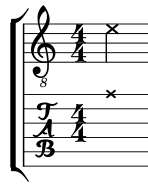This is an old revision of this page, as edited by Hyacinth (talk | contribs) at 04:18, 18 February 2012 (stringed instrument). The present address (URL) is a permanent link to this revision, which may differ significantly from the current revision.
Revision as of 04:18, 18 February 2012 by Hyacinth (talk | contribs) (stringed instrument)(diff) ← Previous revision | Latest revision (diff) | Newer revision → (diff)| This article is an orphan, as no other articles link to it. Please introduce links to this page from related articles; try the Find link tool for suggestions. (February 2012) |

In music, a dead note, also known as a false note, has a rhythmic value, but no discernible pitch when played. On stringed instruments, this is played by sounding a muted string. In musical notation, this is represented by an "X" or a note head in parentheses.
See also
Sources
This music theory article is a stub. You can help Misplaced Pages by expanding it. |